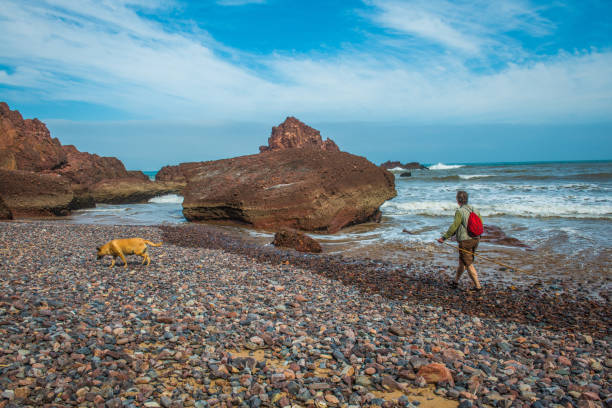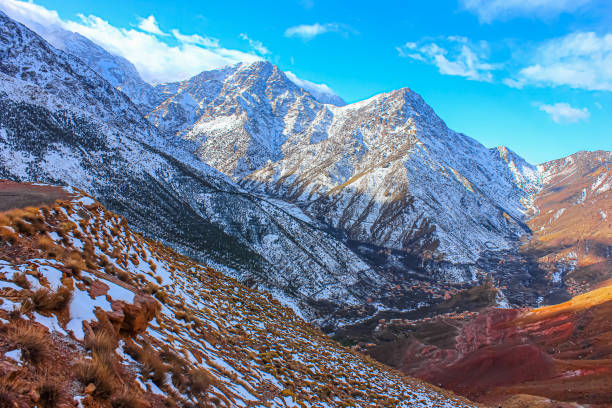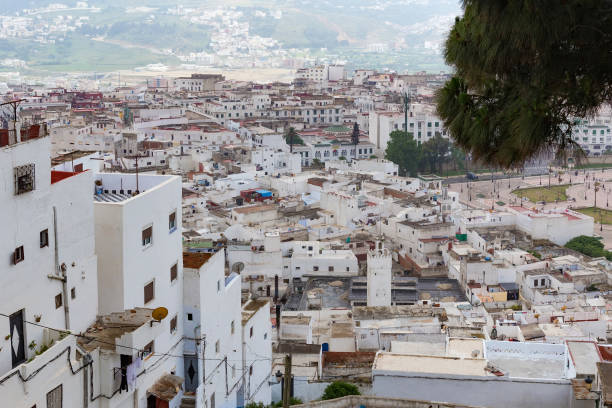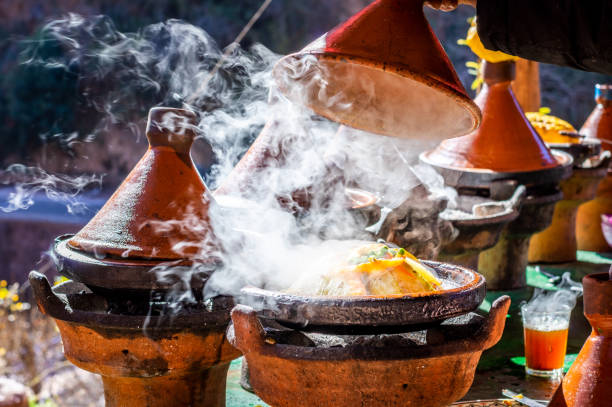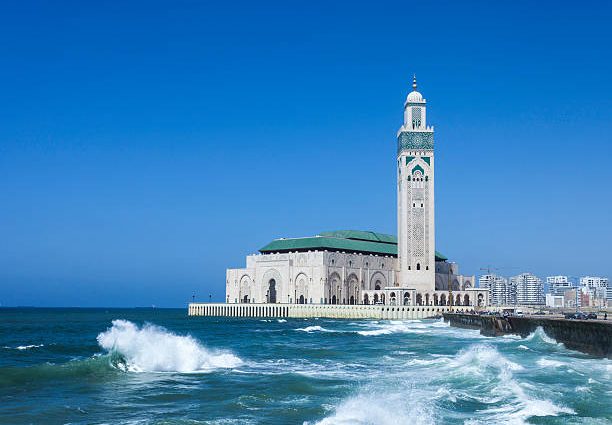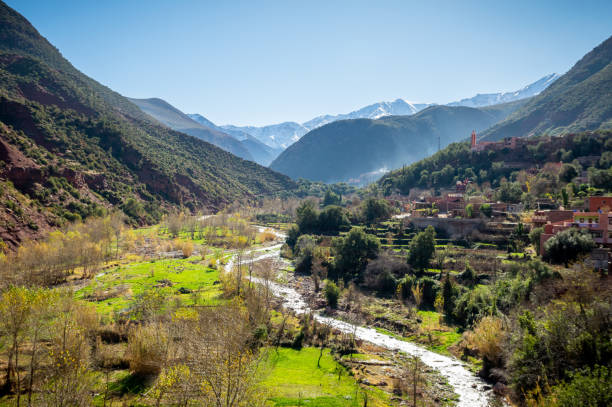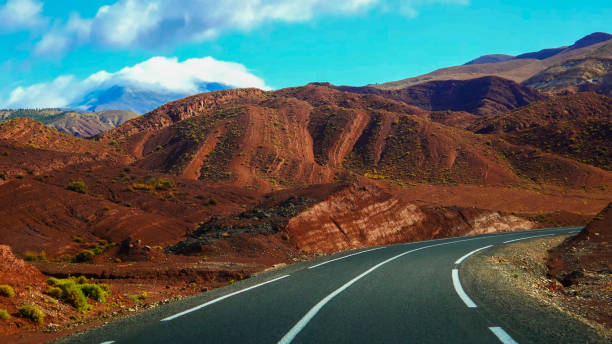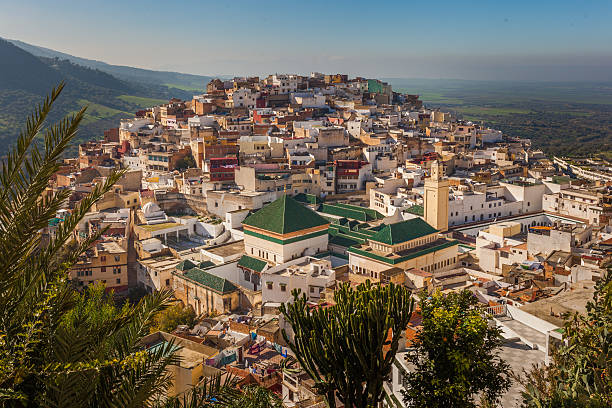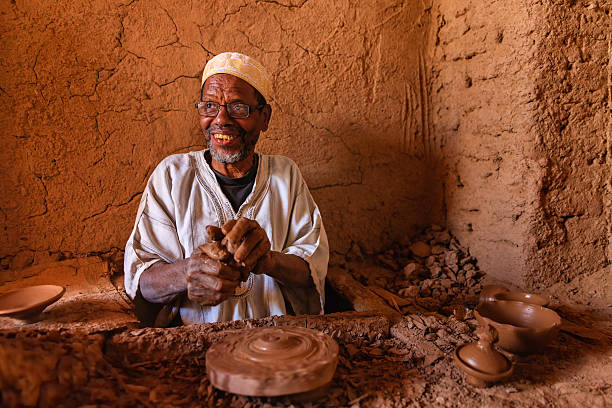Morocco’s diverse landscapes—from towering mountains and vast deserts to dramatic coastlines and lush valleys—create some of the world’s most spectacular road journeys. While destinations like Marrakech, Fez, and Chefchaouen rightfully capture travelers’ imaginations, the routes connecting these iconic locations offer equally memorable experiences for those who appreciate the journey as much as the destination. At Kasbah Transfers, our years traversing Morocco’s highways and backroads have revealed breathtaking vistas, hidden cultural treasures, and the pure joy of discovery that comes from taking the scenic route. Today, we share our insider knowledge of Morocco’s most beautiful road journeys—routes where the travel experience becomes as meaningful as the places they connect.
The Tizi n’Test Pass: Drama in the High Atlas
The Historic Mountain Crossing
Few road journeys in Morocco—or anywhere in the world—match the spectacular Tizi n’Test pass for sheer drama and historical significance. Connecting Marrakech with Taroudant and the Souss Valley, this ancient trade route reaches 2,092 meters (6,867 feet) at its highest point, creating one of North Africa’s most breathtaking mountain crossings.
The road itself represents a remarkable engineering achievement, first constructed during the French Protectorate in the 1920s but following the path of a trade route used for centuries by caravans connecting Marrakech with southern Morocco and beyond. Carved into steep mountainsides, the route features dozens of hairpin turns that create both white-knuckle driving moments and spectacular photo opportunities.
The Journey Experience
The Tizi n’Test journey begins in Marrakech, initially crossing the fertile Haouz plain with its olive groves and orchards. As you approach the mountains, the landscape gradually transforms, becoming increasingly dramatic as the road begins its ascent into the High Atlas.
About an hour from Marrakech, the serious climbing begins near Asni. From here, the road narrows and winds ever upward through Berber villages that cling seemingly impossibly to steep mountainsides. The traditional earthen architecture of these communities blends seamlessly with the landscape, creating scenes that have changed little in centuries.
As you climb higher, vegetation thins and vistas expand. Each switchback reveals new perspectives, with views extending back across valleys to distant peaks. The air noticeably cools and thins as you approach the pass itself.
The summit of Tizi n’Test offers a natural stopping point with expansive views in all directions. On clear days, you can see all the way to the Anti-Atlas mountains and, some say, even glimpse the distant Sahara. A small café at the pass provides welcome refreshment and a chance to absorb the majestic surroundings.
The southern descent delivers perhaps the most spectacular section of the journey. The road clings to the mountainside with sheer drops that are both thrilling and slightly terrifying. The landscape transforms again, becoming increasingly arid as you leave the High Atlas behind and enter the Souss Valley with its distinctive argan forests.
The journey eventually delivers you to Taroudant, a beautiful walled city often called “Little Marrakech” but with a more authentic, less touristed atmosphere. The entire route covers approximately 223 kilometers and typically requires 5-6 hours of driving, though most travelers take significantly longer to allow for photographs, village explorations, and the simple appreciation of one of Morocco’s most magnificent landscapes.
When to Travel
The Tizi n’Test is subject to seasonal considerations that significantly impact the journey:
- Spring (April-May) offers perhaps the ideal conditions, with moderate temperatures, clear visibility, and mountainsides often covered with wildflowers
- Summer (June-September) brings reliable road conditions but potentially uncomfortable heat at lower elevations
- Fall (September-November) provides beautiful clear days with comfortable temperatures
- Winter (December-March) introduces the possibility of snow at higher elevations, occasionally closing the pass entirely
At Kasbah Transfers, we monitor conditions carefully during winter months and may recommend alternative routes when weather threatens the safety or comfort of this high mountain journey.
The Atlantic Coast Route: Where Mountains Meet Ocean
Morocco’s Highway 1
Morocco’s N1 highway along the Atlantic coast creates one of North Africa’s most beautiful seaside journeys. While the entire route extends from Tangier in the north to the Mauritanian border in the south, the most spectacular section runs from Agadir to Essaouira—a stretch where mountains dramatically meet the Atlantic Ocean.
This coastal journey offers a remarkable contrast to Morocco’s inland routes, with crashing waves, fishing villages, and expansive beaches creating a completely different visual and cultural experience.
The Journey Experience
Departing Agadir with its modern resort atmosphere, the coastal route initially passes through agricultural areas where banana plantations and vegetable farms benefit from the mild Atlantic climate. Soon the landscape transforms as the Atlas Mountains approach the coast, creating dramatic cliffs and headlands.
Near Taghazout, formerly a simple fishing village now transformed into a surf destination, the road offers its first spectacular ocean vistas. From here northward, the journey becomes increasingly dramatic as the road alternates between hugging the coastline and climbing headlands that provide panoramic views extending far along the coast.
Particularly breathtaking sections include:
- Imsouane Bay, where a perfect half-moon beach sits beneath towering cliffs
- Cap Sim, where the lighthouse stands sentinel over a wild stretch of coast
- The approach to Essaouira, where the island-dotted bay and whitewashed medina appear like a mirage against the blue Atlantic
Throughout the journey, you’ll pass through small fishing communities where wooden boats are still pulled up on beaches after the morning catch, local markets sell seafood directly from fishermen, and traditional life continues despite growing tourism.
The entire route from Agadir to Essaouira covers approximately 175 kilometers and takes about 3 hours of driving time. However, with abundant photo opportunities, beach stops, and seafood restaurants along the way, most travelers allow at least a half-day for this journey.
When to Travel
The coastal route benefits from Morocco’s mild Atlantic climate, making it enjoyable year-round:
- Spring and Fall offer perfect conditions with moderate temperatures and typically clear skies
- Summer brings reliable weather but sometimes includes coastal fog, particularly in the morning
- Winter can feature dramatic seascapes with powerful waves, though occasional rainfall may interrupt the journey
The consistent climate makes this an excellent alternative when mountain routes face seasonal challenges, offering beautiful driving conditions even during winter months when interior regions may experience more extreme weather.
The Dadès Valley: The Road of a Thousand Kasbahs
Morocco’s Living History Highway
The route through Morocco’s Dadès Valley offers a journey through both spectacular natural landscapes and extraordinary human history. Often called “The Road of a Thousand Kasbahs,” this route passes countless traditional fortified earthen structures set against a backdrop of dramatically eroded mountains and lush valley gardens.
This journey connects the desert gateway town of Ouarzazate with the heights of the High Atlas via one of Morocco’s most culturally rich corridors.
The Journey Experience
Beginning in Ouarzazate, home to famous film studios and the impressive Taourirt Kasbah, the journey follows the N10 highway eastward. Almost immediately, the landscape reveals its distinctive character—a ribbon of green valley floor where agriculture flourishes, bordered by dramatically eroded red-rock formations and backed by barren mountains.
The route passes through Skoura, an ancient caravan stop whose sprawling palm oasis houses several of Morocco’s best-preserved kasbahs. Most notable is Kasbah Amridil, a 17th-century fortified residence that has been carefully maintained and remains partially inhabited by descendants of the original builders.
Continuing eastward, the true “Road of a Thousand Kasbahs” section unfolds between Skoura and Boumalne Dadès. Here, traditional fortified villages and noble kasbahs appear in seemingly endless succession, their earthen towers rising dramatically against the landscape. Each bend in the road reveals new compositions of architecture and nature working in perfect harmony.
At Boumalne Dadès, the main route continues east toward Tinghir and the Todra Gorge, but the most spectacular section diverts north into the Dadès Gorge proper. Here, the road performs an engineering marvel as it winds upward through a landscape of twisted rock formations often described as “monkey fingers” due to their distinctive shape.
The most dramatic section includes a series of tight switchbacks that provide both driving challenge and photographic marvel. At various points, the road threads through narrow defiles where the gorge walls tower hundreds of meters above, creating a cathedral-like atmosphere of red rock and shifting light.
Small traditional villages cling to seemingly impossible locations throughout the gorge, their earthen architecture blending seamlessly with the surrounding rock. Many communities maintain traditional agricultural practices on small terraced fields that create patches of startling green against the red landscape.
The journey through the Dadès Valley from Ouarzazate to the upper reaches of the gorge covers approximately 100 kilometers and requires around 3 hours of driving. However, with abundant cultural and natural attractions along the route, most travelers spend a full day or more exploring this remarkable region.
When to Travel
The Dadès Valley route offers excellent conditions through much of the year:
- Spring brings snow-melt from the High Atlas, creating flowing wadis and maximizing the contrast between green valley floors and red rock formations
- Fall offers clear skies and comfortable temperatures ideal for photography and exploration
- Winter occasionally brings snow to the upper gorge, creating spectacular scenery but sometimes challenging driving conditions
- Summer brings reliable road conditions but potentially extreme heat, particularly in the lower valley
As with all mountain routes, we recommend starting early in summer months to avoid midday heat, while in winter, later departures allow morning ice to clear from higher sections.
The Middle Atlas Cedar Forest Route: Alpine Morocco
Morocco’s Unexpected Alpine Landscape
For travelers expecting only desert and arid mountains, the Middle Atlas route between Fez and Midelt delivers a surprising landscape that seems transported from Alpine Europe. This journey passes through North Africa’s largest cedar forest, complete with lakes, meadows, and distinctive wildlife including the famous Barbary macaques.
The route showcases a completely different face of Morocco—one of cool forests, mountain streams, and architecture more reminiscent of the Alps than North Africa.
The Journey Experience
Departing the ancient city of Fez, the route climbs steadily into the Middle Atlas mountains. The landscape transforms dramatically within the first hour, transitioning from Mediterranean-type vegetation to increasingly dense forests dominated by cork oak, holm oak, and eventually the massive Atlas cedars.
The journey’s first highlight comes at Ifrane, Morocco’s “Little Switzerland.” This mountain resort town, built by the French in the 1930s as a cool retreat from summer heat, features Alpine-style architecture complete with sloped roofs designed for snow. The immaculately maintained town center, with its parks and lakes, creates a surreal European enclave in the Moroccan mountains.
Beyond Ifrane, the route enters its most spectacular section as it passes through the Cedar Forest of Azrou. These ancient trees, some over 800 years old, create a majestic canopy over the winding mountain road. The forest is home to troops of Barbary macaques, endemic to North Africa’s mountain regions and often visible near the roadside.
The route continues through the mountain town of Azrou before climbing toward the Middle Atlas’s highest reaches. Here, the landscape opens into high plateaus where lakes reflect mountain scenery and Berber shepherds tend flocks in verdant summer pastures.
As the journey continues toward Midelt, the eastern slopes of the Middle Atlas present a stark transition—the lush forests gradually giving way to more arid landscapes that herald the approach to the high plateau separating the Middle Atlas from the High Atlas range.
The complete journey from Fez to Midelt covers approximately 200 kilometers and takes about 3-4 hours of direct driving. With stops for wildlife viewing, photography, and perhaps a coffee in Ifrane, most travelers allocate at least half a day to this remarkable route.
When to Travel
The Middle Atlas route offers distinct seasonal experiences:
- Spring brings wildflower displays across mountain meadows and comfortable temperatures
- Summer provides reliable access with pleasant temperatures significantly cooler than Morocco’s cities
- Fall offers spectacular foliage as deciduous trees change color while cedar remains evergreen
- Winter transforms the landscape into a snow-covered wonderland, though requiring winter driving precautions
This route provides particularly valuable contrast during summer months, when its cool mountain climate offers welcome relief from the heat of imperial cities.
The Desert Gateway: Erfoud to Merzouga
The Approach to the Great Sand Sea
While many desert routes offer spectacular scenery, few match the dramatic transition experienced on the journey from Erfoud to Merzouga—the gateway to Morocco’s section of the Sahara. This relatively short but extraordinary route delivers travelers from a desert town to the foot of the spectacular Erg Chebbi dunes, creating a journey of constantly intensifying anticipation.
This route’s magic lies in its graduated revelation of the desert’s most iconic landscape—the massive sand sea that features in countless images of Morocco.
The Journey Experience
Beginning in Erfoud, a desert market town known for its date cultivation and fossil quarries, the journey initially passes through a flat, rocky desert landscape typical of much of Morocco’s southeast. The distinctive black desert surface—known as “hammada”—stretches toward distant horizons broken only by occasional palmeraies (palm oases) where groundwater permits cultivation.
As you continue southeast, subtle changes in the landscape build anticipation—patches of sand begin to appear with increasing frequency among the rock, and distant mounds on the horizon gradually resolve into the first outlying dunes of Erg Chebbi.
Approximately 20 kilometers from Erfoud, you’ll pass through Rissani, a historical oasis town that once served as the desert capital and remains an important market center for surrounding communities. The town’s impressive gate and busy souk provide excellent opportunities to experience authentic desert commerce largely unchanged for centuries.
Beyond Rissani, the transformation accelerates. The rocky desert increasingly gives way to sand, while the Erg Chebbi dunes—previously just a distant smudge on the horizon—begin to dominate the view ahead. Their color shifts with the changing light, from pale gold in harsh midday sun to rich orange and red tones as the day progresses.
The final approach to Merzouga delivers the journey’s most dramatic moment as the massive dunes suddenly appear in their full glory—rising up to 150 meters from the surrounding flat desert, their perfect wind-sculpted curves creating nature’s most elegant sculptures. The scale becomes increasingly apparent as you approach, with the dunes dwarfing the small settlement of Merzouga that sits at their base.
The entire route from Erfoud to Merzouga covers just 55 kilometers and takes approximately one hour of driving time. However, with stops at Rissani, fossil shops, and various viewpoints along the way, most travelers allow 2-3 hours to fully appreciate this transformative desert journey.
When to Travel
The desert gateway route offers distinctly different experiences throughout the year:
- Spring and Fall provide ideal conditions with moderate temperatures and excellent visibility
- Winter brings comfortable daytime temperatures but potentially very cold nights
- Summer requires careful planning around extreme heat, with early morning or late afternoon departures strongly recommended
Regardless of season, timing this journey to reach the dunes near sunrise or sunset maximizes the visual impact as low-angle light brings out the dunes’ sculptural qualities through shadow and warm color.
The High Atlas Traverse: Tizi n’Tichka Pass
The Great Mountain Highway
No discussion of Morocco’s scenic routes would be complete without including the Tizi n’Tichka—the major mountain pass connecting Marrakech with Ouarzazate and Morocco’s southern regions. While now more heavily traveled than some routes in this guide, the Tizi n’Tichka remains one of North Africa’s most spectacular mountain journeys and the highest major mountain crossing in Morocco at 2,260 meters (7,415 feet).
Unlike the narrower, more dramatically winding Tizi n’Test, the Tizi n’Tichka represents a major engineered highway capable of handling significant traffic. This accessibility has made it Morocco’s primary north-south artery, yet it sacrifices none of the High Atlas’s majesty in creating this vital connection.
The Journey Experience
Departing Marrakech, the route initially crosses the fertile Haouz plain before beginning its ascent into the mountains. The transition happens gradually, with foothills giving way to increasingly dramatic terrain as the road climbs steadily through a series of switchbacks and curves that follow the natural contours of the mountains.
Unlike the Tizi n’Test’s narrow ledge-hugging character, the Tizi n’Tichka features broader vistas across wide valleys and distant peaks. The road alternates between tight curves and longer straightaways that allow more relaxed appreciation of the surrounding scenery.
Traditional Berber villages appear throughout the journey, their earthen architecture blending harmoniously with the mountainsides. Several larger settlements offer opportunities to pause for mint tea or mountain cuisine, while numerous viewpoints provide perfect photography stops with expansive panoramas.
The pass itself features a broad area with several cafés and souvenir stands marking the highest point of the journey. From here, on clear days, views extend in all directions across the High Atlas range. A monument marking the pass elevation provides the obligatory photo opportunity commemorating the crossing.
The southern descent presents a dramatic transformation as the landscape gradually becomes more arid, with vegetation thinning and colors shifting toward the ochre and red tones characteristic of Morocco’s pre-Saharan regions. The final approach to Ouarzazate reveals an almost lunar landscape of barren hills before reaching the cultivated areas surrounding the city itself.
The complete Tizi n’Tichka journey from Marrakech to Ouarzazate covers approximately 200 kilometers and requires about 4 hours of driving time under good conditions. With stops for photography, refreshments, and perhaps visits to roadside craft cooperatives, most travelers allocate 5-6 hours for this crossing.
When to Travel
The Tizi n’Tichka’s status as a major highway means it receives priority for clearing during adverse conditions, making it more consistently passable than smaller mountain routes:
- Spring and Fall offer ideal conditions with pleasant temperatures and clear visibility
- Summer brings reliable road conditions but potentially uncomfortable heat at lower elevations
- Winter occasionally brings snow at higher elevations, creating beautiful scenery but sometimes causing temporary closures
As Morocco’s primary southern access route, the road receives prompt attention following winter storms, typically reopening within hours rather than the days sometimes required for smaller mountain passes.
The Northern Rif Route: Mediterranean Morocco
Morocco’s Emerald Mountains
The northern Rif Mountains create a completely different Moroccan landscape—one of lush forests, small farms, and distinctive blue-washed towns. The route connecting Chefchaouen with Al Hoceima follows winding mountain roads through some of Morocco’s most verdant terrain, revealing a Mediterranean character distinct from the country’s more arid regions.
This journey showcases Morocco’s remarkable diversity, presenting landscapes and cultural elements that seem transported from southern Europe yet maintain distinctively Moroccan character.
The Journey Experience
Beginning in Chefchaouen, Morocco’s famous “Blue City” nestled in the Rif Mountains, the route initially climbs through forests of cork oak and pine that create an almost Alpine atmosphere. The road winds along mountainsides offering periodic views back toward Chefchaouen’s blue-washed medina set against green mountains—one of Morocco’s most iconic vistas.
As the journey continues eastward, it passes through small Rif mountain villages where traditional agriculture continues on terraced hillsides. Unlike the earthen architecture of southern Morocco, buildings here feature whitewashed walls and often tile roofs, reflecting the region’s greater rainfall and Spanish influences.
The route alternates between mountain passes offering spectacular panoramas and descents into valleys where rivers have created fertile corridors supporting orchards and small farms. The overall impression is one of surprising lushness—a green Morocco that contradicts common perceptions of the country as primarily desert and arid mountains.
Approximately halfway through the journey, the Mediterranean becomes visible in the distance—a blue horizon that grows increasingly dominant as the route approaches the coast. The final section follows the coastline, with the road periodically rising over headlands that provide spectacular views across the Mediterranean Sea.
The journey concludes in Al Hoceima, a relaxed coastal city set on a beautiful bay. The complete route covers approximately 200 kilometers and requires about 4 hours of driving time, though most travelers take significantly longer to fully appreciate the diverse landscapes and villages along the way.
When to Travel
The northern Rif route experiences a Mediterranean climate with distinct seasonal characteristics:
- Spring brings extraordinary wildflower displays across mountain meadows and comfortable temperatures
- Summer offers reliable conditions though with greater heat, particularly at lower elevations
- Fall provides clear skies and moderate temperatures ideal for photography and exploration
- Winter receives the region’s highest rainfall, occasionally complicating travel but creating lush, vibrant landscapes
The northern route offers particularly valuable diversity during extended Moroccan itineraries, presenting ecosystems and cultural elements not found elsewhere in the country.
The Practical Side of Scenic Routes
Vehicle Considerations
Morocco’s most beautiful roads often present driving challenges that require appropriate vehicles and skills:
- Mountain routes feature narrow sections, tight switchbacks, and occasionally rough surfaces that demand vehicles with good handling and adequate power
- Desert approaches sometimes include sections of unpaved road or soft sand requiring higher clearance and occasionally 4WD capability
- Coastal journeys generally present fewer challenges but benefit from vehicles offering good visibility for scenic appreciation
At Kasbah Transfers, we match vehicles specifically to planned routes, ensuring both safety and comfort for each journey’s particular demands.
Safety and Comfort
Several considerations enhance both safety and enjoyment on Morocco’s scenic routes:
- Timing departures to avoid darkness on challenging roads—sunset comes quickly in mountain areas
- Weather monitoring especially during winter months when conditions can change rapidly
- Regular stops not just for photography but to prevent fatigue on winding roads
- Appropriate provisions including water, snacks, and sun protection for areas with limited services
Professional drivers familiar with specific routes significantly enhance both safety and the overall experience, particularly on more challenging mountain and desert journeys.
Photography Considerations
Morocco’s scenic routes offer extraordinary photography opportunities enhanced by:
- Early departures to capture morning light on eastern-facing landscapes
- Strategic timing for sunset positioning at particularly scenic locations
- Awareness of light direction when planning route direction and timing
- Identifying elevated viewpoints that provide broader panoramas
The best routes often feature natural stopping points where optimal photography combines with safe parking—locations our drivers know through years of experience.
The Kasbah Transfers Approach to Scenic Journeys
At Kasbah Transfers, we believe Morocco’s scenic routes deserve more than mere transportation—they warrant thoughtful journey design that transforms travel time into a central part of the Moroccan experience.
Route Expertise
Our drivers bring deep knowledge to each journey:
- Historical context explaining how routes developed and their significance in Moroccan history
- Architectural insights highlighting regional building styles and their environmental adaptations
- Cultural background illuminating the communities encountered along each route
- Natural history identifying distinctive ecosystems and their characteristic flora and fauna
This contextual layer transforms scenic appreciation from purely visual experience to deeper understanding.
Timing Optimization
We carefully plan departures and pacing to enhance each route:
- Capturing optimal light by timing mountain passes for mid-morning or late afternoon
- Avoiding crowds at popular viewpoints by slightly adjusting traditional schedules
- Coordinating with natural phenomena like nomadic migrations or seasonal agriculture
- Building in flexibility for unexpected discoveries or particularly photogenic conditions
These timing considerations often make the difference between a pleasant drive and an extraordinary journey.
Local Connections
Our extensive networks throughout Morocco allow us to incorporate:
- Authentic food experiences in small restaurants known primarily to locals
- Craft demonstrations in workshops along scenic routes
- Cultural interactions with communities rarely visited by independent travelers
- Special access to viewpoints or properties not generally open to the public
These connections add human dimensions to the natural beauty of Morocco’s most scenic routes.
Conclusion: The Journey as Destination
Morocco’s remarkable diversity—geographical, cultural, and historical—reveals itself most completely through its scenic routes. While iconic destinations rightfully attract travelers’ attention, the journeys between these places offer equally valuable insights into the country’s soul. From mountain passes where snow-capped peaks touch the sky to desert approaches where sand seas stretch to the horizon, these routes create experiences as memorable as any medina or monument.
For travelers willing to embrace slower, more thoughtful movement through Morocco, these scenic journeys offer rewards beyond spectacular photography—they provide windows into landscapes that have shaped human culture and adaptation for millennia. They reveal Morocco not as a collection of disconnected highlights but as a continuous tapestry of interconnected environments and communities.
As a traditional Moroccan proverb suggests, “Only in the journey can you understand the land.” We at Kasbah Transfers invite you to experience Morocco’s most beautiful routes not merely as transitions between destinations but as essential experiences in themselves—journeys where every curve in the road brings new wonder and deeper understanding of this extraordinary country.
Ready to experience Morocco’s most spectacular road journeys? Contact Kasbah Transfers to arrange transportation with knowledgeable drivers who transform travel time into one of your journey’s highlights. Whether you’re seeking mountain drama, coastal beauty, or desert mystique, our team will create the perfect scenic route experience tailored to your interests, schedule, and comfort preferences.

